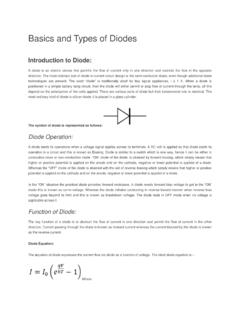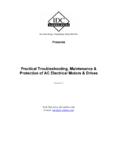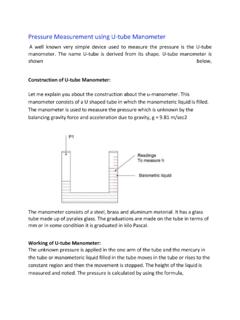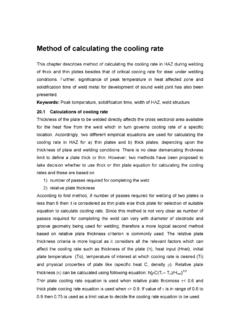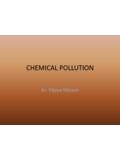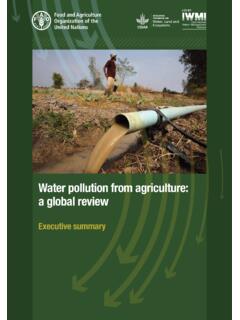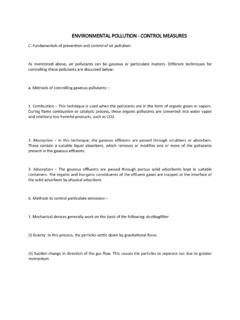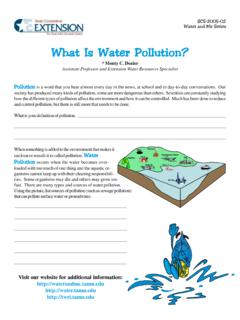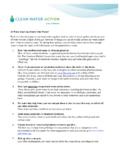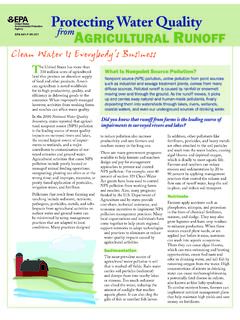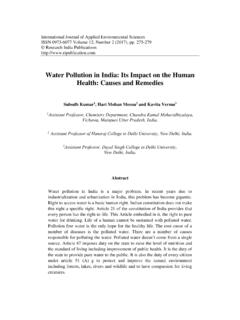Transcription of ENVIRONMENTAL POLLUTION AND PROBLEMS - idc …
1 ENVIRONMENTAL POLLUTION AND P ROBLEMS A. Introduction and definition of ENVIRONMENTAL POLLUTION We know that, a living organism cannot live by itself. Organisms interact among themselves. Hence, all organisms, such as plants, animals and human beings, as well as the physical surroundings with whom we interact, form a part of our environment. All these constituents of the environment are dependent upon each other. Thus, they maintain a balance in nature. As we are the only organisms try to modify the environment to fulfill our needs; it is our responsibility to take necessary steps to control the ENVIRONMENTAL imbalances. The ENVIRONMENTAL imbalance gives rise to various ENVIRONMENTAL PROBLEMS . Some of the ENVIRONMENTAL PROBLEMS are POLLUTION , soil erosion leading to floods, salt deserts and sea recedes, desertification, landslides, change of river directions, extinction of species, and vulnerable ecosystem in place of more complex and stable ecosystems, depletion of natural resources, waste accumulation, deforestation, thinning of ozone layer and global warming.
2 The ENVIRONMENTAL PROBLEMS are visualized in terms of POLLUTION , growth in population, development, industrialization, unplanned urbanization etc. Rapid migration and increase in population in the urban areas has also lead to traffic congestion, water shortages, solid waste, and air, water and noise POLLUTION are common noticeable PROBLEMS in almost all the urban areas since last few years. ENVIRONMENTAL POLLUTION is defined as the undesirable change in physical, chemical and biological characteristics of our air, land and water . As a result of over-population, rapid industrializations, and other human activities like agriculture and deforestation etc., earth became loaded with diverse pollutants that were released as by-products. Pollutants are generally grouped under two classes: (a) Biodegradable pollutants - Biodegradable pollutants are broken down by the activity of micro-organisms and enter into the biogeochemical cycles.
3 Examples of such pollutants are domestic waste products, urine and faucal matter, sewage, agricultural residue, paper, wood and cloth etc. (b) Non- Biodegradable pollutants - Non-biodegradable pollutants are stronger chemical bondage, do not break down into simpler and harmless products. These include various insecticides and other pesticides , mercury, lead, arsenic, aluminum, plastics, radioactive waste etc. B. Classification of ENVIRONMENTAL POLLUTION - POLLUTION can be broadly classified according to the components of environment that are polluted. Major of these are: Air POLLUTION , water POLLUTION , Soil POLLUTION (land degradation) and Noise POLLUTION . Details of these types of pollutions are discussed below with their prevention measures. (1) Air POLLUTION : Air is mainly a mixture of various gases such as oxygen, carbon dioxide, nitrogen.
4 These are present in a particular ratio. Whenever there is any imbalance in the ratio of these gases, air POLLUTION is caused. The sources of air POLLUTION can be grouped as under PDS_AIR_POLLUTION_0 (i) Natural; such as, forest fires, ash from smoking volcanoes, dust storm and decay of organic matters. (ii) Man-made due to population explosion, deforestation, urbanization and industrializations. Certain activities of human beings release several pollutants in air, such as carbon monoxide (CO), sulfur dioxide (SO2), hydrocarbons (HC), oxides of nitrogen (NOx), lead, arsenic, asbestos, radioactive matter, and dust. The major threat comes from burning of fossil fuels, such as coal and petroleum products. Thermal power plants, automobiles and industries are major sources of air POLLUTION as well. Due to progress in atomic energy sector, there has been an increase in radioactivity in the atmosphere.
5 Mining activity adds to air POLLUTION in the form of particulate matter. Progress in agriculture due to use of fertilizers and pesticides has also contributed towards air POLLUTION . Indiscriminate cutting of trees and clearing of forests has led to increase in the amount of carbon dioxide in atmosphere. Global warming is a consequence of green house effect caused by increased level of carbon dioxide (CO2). Ozone (O3) depletion has resulted in UV radiation striking our earth. The gaseous composition of unpolluted air The Gases Parts per million (vol) Nitrogen 756,500 Oxygen 202,900 water 31,200 Argon 9,000 Carbon Dioxide 305 Neon Helium Methane Krypton Nitrous oxide Hydrogen Xenon Organic vapours Harmful Effects of air POLLUTION (a) It affects respiratory system of living organisms and causes bronchitis, asthma, lung cancer, pneumonia etc.
6 Carbon monoxide (CO) emitted from motor vehicles and cigarette smoke affects the central nervous system. (b) Due to depletion of ozone layer, UV radiation reaches the earth. UV radiation causes skin cancer, damage to eyes and immune system. (c) Acid rain is also a result of air POLLUTION . This is caused by presence of oxides of nitrogen and sulfur in the air. These oxides dissolve in rain water to form nitric acid and sulfuric acid respectively. Various monuments, buildings, and statues are damaged due to corrosion by acid present in the rain. The soil also becomes acidic. The cumulative effect is the gradual degradation of soil and a decline in forest and agricultural productivity. (d) The green house gases, such as carbon dioxide (CO2) and methane (CH4) trap the heat radiated from earth. This leads to an increase in earth s temperature.
7 (e) Some toxic metals and pesticides also cause air POLLUTION . [For more refer Industrial Dust, Air POLLUTION and Related Occupational Diseases ] (2) water POLLUTION : water is one of the prime necessities of life. With increasing number of people depend on this resource; water has become a scarce commodity. POLLUTION makes even the limited available water unfit for use. water is said to be polluted when there is any physical, biological or chemical change in water quality that adversely affects living organisms or makes water unsuitable for use. Sources of water POLLUTION are mainly factories, power plants, coal mines and oil wells situated either close to water source or away from sources. They discharge pollutants directly or indirectly into the water sources like river, lakes, water streams etc.
8 The harmful effects of water POLLUTION are: (a) Human beings become victims of various water borne diseases, such as typhoid, cholera, dysentery, hepatitis, jaundice, etc. (b) The presence of acids/alkalies in water destroys the microorganisms, thereby hindering the self-purification process in the rivers or water bodies. Agriculture is affected badly due to polluted water . Marine eco-systems are affected adversely. (c) The sewage waste promotes growth of phytoplankton in water bodies; causing reduction of dissolved oxygen. (d) Poisonous industrial wastes present in water bodies affect the fish population and deprives us of one of our sources of food. It also kills other animals living in fresh water . (e) The quality of underground water is also affected due to toxicity and pollutant content of surface water . ( ) water POLLUTION by industries and its effects - Industrial_WaterPollutionA change in the chemical, physical, biological, and radiological quality of water that is injurious to its uses.
9 The term water POLLUTION generally refers to human-induced changes to water quality. Thus, the discharge of toxic chemicals from industries or the release of human or livestock waste into a nearby water body is considered POLLUTION . The contamination of ground water of water bodies like rivers, lakes, wetlands, estuaries, and oceans can threaten the health of humans and aquatic life. Sources of water POLLUTION may be divided into two categories. (i) Point-source POLLUTION , in which contaminants are discharged from a discrete location. Sewage outfalls and oil spills are examples of point-source POLLUTION . (ii) Non-point-source or diffuse POLLUTION , referring to all of the other discharges that deliver contaminants to water bodies. Acid rain and unconfined runoff from agricultural or urban areas falls under this category.
10 The principal contaminants of water include toxic chemicals, nutrients, biodegradable organics, and bacterial & viral pathogens. water POLLUTION can affect human health when pollutants enter the body either via skin exposure or through the direct consumption of contaminated drinking water and contaminated food. Prime pollutants, including DDT and polychlorinated biphenyls (PCBs), persist in the natural environment and bioaccumulation occurs in the tissues of aquatic organisms. These prolonged and persistent organic pollutants are transferred up the food chain and they can reach levels of concern in fish species that are eaten by humans. Moreover, bacteria and viral pathogens can pose a public health risk for those who drink contaminated water or eat raw shellfish from polluted water bodies. Contaminants have a significant impact on aquatic ecosystems.
